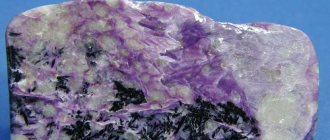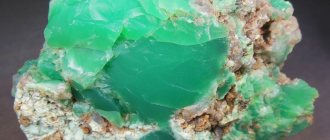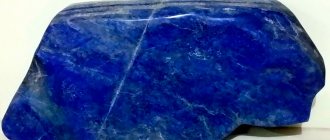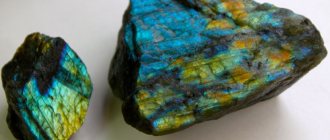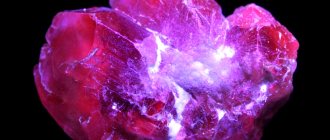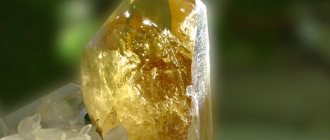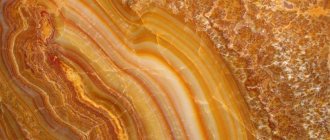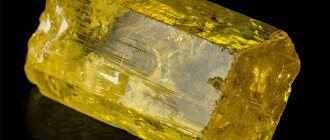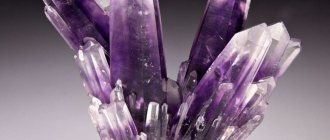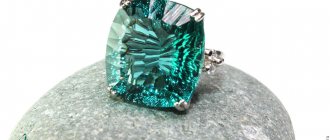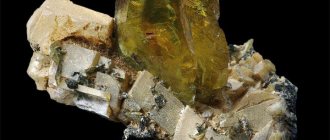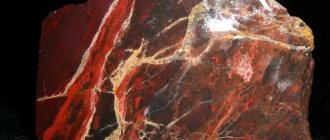Allanite is a unique nugget whose mineral composition is close to epidote. The stone is a desirable piece for many collectors and representatives of the magical sphere, but finding it on the shelf of the jewelry department is very difficult. Therefore, the gem does not fall into the hands of every person, but its owner is endowed with a wide range of possibilities.
History of origin
The stone owes its name to its discoverer, the Scottish mineralogist Thomas Allan. In honor of him, the nugget received its modern famous name. Geologists more often call the stone orthite. This word originated in ancient Greek, where it is translated into Russian as “correct.” The crystals that form the mineral justify this name. They are prism-shaped units with perfectly smooth edges.
Orthite was first discovered by researchers on the island of Greenland in the early 19th century. Long before the discovery, the alchemists of the Middle Ages were interested in ways to extract beneficial qualities from this material. Paracelsus described the properties of the stone in his notes, but the information that it was orthite has not been confirmed.
Characteristics and properties of allanite
The mineral belongs to the group of silicates. Its chemical formula varies depending on the composition of the stone. The crystals contain lanthanum, cerium, dysprosium, erbium and vanadium - some of the rarest chemical elements.
Physicochemical characteristics
- Orthitis has dark shades of color. The color can be brown, brown, dark gray or black, depending on the content of the components.
- There are varieties that completely or partially transmit rays of light, and there are also those stones that completely lack transparency.
- The luster of orthite is greasy, and at the fracture it is glassy.
- The nugget does not conduct electric current, that is, it is a dielectric.
- Hardness on the Mohs scale ranges from 5 to 6.
- The cleavage of a nugget, that is, the ability to split in certain directions, is imperfect.
- When the crystal rotates, a color change occurs. This property is called pleochroism.
- Silicate is radioactive, but this indicator is acceptable and safe for humans.
- The mineral has a monoclinic system and a conchoidal fracture.
- Crystals may have magnetic properties that arise due to changing conditions.
Magic properties
Psychics, healers and esotericists have not ignored this wonderful mineral. It has found wide application in the field of magic. The nugget is used for various rituals and ceremonies aimed at enriching the body with vitality and energy.
The crystal keeps the owner sane, protecting him from evil thoughts. All negative energy is absorbed by the stone and comes out of it in a positive form.
The nugget helps you find harmony with your body and nature. It develops intuition, giving rise to the makings of a psychic in a person.
Ortite creates a protective barrier against any negative energy. The stone is able to suppress outbursts of anger not only in its owner, but also in his opponent. In this way, business people will be able to establish contact with someone and conduct successful negotiations.
Magicians of all times use the gem to protect against otherworldly forces and to establish safe contact with the afterlife. This is how sorcerers find answers to questions and try to solve all the secrets and riddles.
Medicinal properties
Ortitis has found a place in the treatment of eye diseases. With its help, you can relieve swelling and fatigue of the eyes, relieve muscle tension and calm your body as a whole. In this case, preference should be given only to relatively light stones with a yellowish tint.
Brown specimens are suitable for the prevention and treatment of diseases of the circulatory system. They relieve their owner from migraines, fatigue and normalize sleep.
Description of the stone
Allanite (orthite) is a stone of the silicate group, close to epidote. Contains rare earth compounds. The gem has increased radioactivity, but within safe levels for humans.
Characteristics of the stone:
- appearance - opaque or translucent;
- color - black, brown, brown, there are yellow, gray, green shades;
- shine - waxy, pearlescent;
- the structure is straight prismatic.
Allanite was first described by T. Allan in 1811, the mineral is named after his last name. By type, there is a stone with neodymium (found in 2011), cerium, lanthanum, yttrium, and other rare earth elements.
The mineral is formed in magma, pegmatites. In nature it occurs in granite and silicate rocks. It occurs in the form of grains and often grows together with quartz, spar, and zircon.
Allanite is mined in deposits:
- Norway and other Nordic countries;
- Canada;
- Madagascar;
- Karelia;
- Ural.
A natural gem is distinguished from fakes by its radioactivity. The increased background will be shown by the dosimeter, and in a joint with another rock - a dark halo around the allanite grain. Also, there are no natural specimens of bright color and pronounced shine.
Varieties
Ortit does not have a rich palette of shades. The main colors recorded are black, brown and brown.
In addition to color, minerals are classified by composition. The main types: magnesium, manganese, cerium, yttrium, scandium, thoride and beryllium. The name changes depending on the percentage of elements.
In addition, samples are distributed according to the degree of transparency. Some specimens are distinguished by a high level of light transmission, while others, on the contrary, are completely opaque.
Chemical composition
Highly variable.
The chemical composition reveals large fluctuations in the contents of individual oxides.
Calcium oxide (CaO) - 7-12%, aluminum oxide (Al203) 13-19%, iron oxide (Fe203) 3-8%, cerium oxide (Ce203) 3-10%, lanthanum oxide (La203) 4-8% , yttrium oxide (U203) 0.8-4%, thorium oxide (ThO2) 0.3-2.5%, silicon dioxide (SiO2) 30-33%, water (H2O) 2-10%
In addition to the components given in the chemical formula, Na2O, FeO, sometimes MgO, MnO, Y2O3 - up to 8% ( allanite ( Y), yttroortite), Sc2O3, ThO2, sometimes BeO - up to 3.8% are also found.
Place of Birth
The largest deposits of allanite are located in Russia, Finland, Sweden, the USA and Norway. Nugget crystals were discovered on the territory of the Russian Federation in Karelia and the Urals
Mineral deposits are represented by crystalline stones. Orthite is often found with quartz, feldspar, titanium and zircon. Deposits of the mineral are associated with granites, pegmatites and gneiss rocks. Here you can find deposits of both elongated orthite crystals and small inclusions of rare nuggets. Crystals framed with related epidote look incredibly beautiful. Outwardly, it resembles an open bud of a beautiful flower.
To obtain a pure mineral, you must first extract granite, syenite or gneiss rock, and then drill it and separate the necessary components, getting rid of impurities.
Crystallographic characteristics
Monoclinic system; rhomboprismatic c. With. L2RS.
Prismatic c. pp., is isostructural with epidote, hence the analogy in the habit of these two minerals.
Symmetry class. Prismatic - 2m Axial ratio. 1.562:1:1.779; В=115°оо'.
Form of being in nature
The appearance of the crystals is thick tabular, sometimes columnar.
Twins are common along {100}, less often along {001}.
Aggregates. Often found in the form of interspersed grains, less often in a continuous form.
Areas of use
The rare mineral is popular in the scientific field. It has been studied by mineralogists and geologists from different countries for many years. Unique rare earth chemical elements are extracted from it, which are used for the benefit of humanity.
Ortit found a place for himself in the jewelry business. Craftsmen have little love for this stone, so jewelry made from it is mostly made to order. The reason for this is the radioactivity of the material. It is safe for humans, but only if it is not kept close to you for a long time. It is almost impossible to find products with orthitis on the consumer market.
Areas of application of stone and its cost
Allanite is a valuable mineral for science and industry. Due to its chemical composition, this nugget has a main purpose - to serve as a raw material for the extraction of rare earth elements. The most important component of orthite is thorium, the demand for which is constantly increasing. In addition to thorium, beryllium and yttrium are considered valuable.
In the jewelry industry, allanite is considered a rare gemstone. However, only a few craftsmen work with the mineral and only on private orders. The reason is the radioactivity of the mineral. Additionally, the color range of allanite is not considered attractive. Therefore, it is impossible to find jewelry with orthitis on the shelves of jewelry boutiques. How to find out the true value of a gem. It is only known that the approximate price of a 5-carat insert varies between $75-100. The samples that jewelers work with are usually transparent or translucent.
Stone ring
If jewelers are not too fond of allanite, then esotericists and collectors fight for every piece. For the former, the mineral is a valuable magical attribute that opens gates to parallel worlds. In addition, orthite is considered a powerful amulet. For the latter, the gem is an irreplaceable part of mineralogical collections, especially rare crystals reaching a length of up to 70 cm.
Jewelry and care
Small nugget crystals are set into rings, earrings, beads, necklaces and bracelets. It is framed with different materials, but finding such decoration is quite difficult.
Orthite crystals disintegrate when exposed to sunlight. Products containing this mineral should be protected from prolonged exposure to light. It is important to protect the specimen from any type of physical impact. It is best to store such jewelry in a separate box and in an airtight package.
Who are they suitable for?
Ortite perfectly complements the image of such zodiac signs as Cancer, Scorpio and Pisces. It helps them cope with life's difficulties on a difficult thorny path, replenishing energy reserves and giving self-confidence.
A nugget can become an excellent talisman for journalists, educators and educators. It is useful for professions related to communications.
Astrologers unanimously say that orthitis does not cause harm and does not aggravate the negative qualities of people. Jewelry can be purchased by everyone, regardless of a person’s zodiac affiliation and characteristics.
Crystal optical properties in thin preparations (sections)
In thin sections brown with strong pleochroism; o Np yellowish, Nm brown to dark brown, Ng reddish-brown, green to greenish-brown. np 1.64 -t- 1.78, nm 1.65 -t- 1.80, ng = 1.66 -g- 1.81. The plane of the optical axes is usually parallel to {010} with an angle Np = 30 - 40° and (-)2V ~ 70°. Magnesioortite is optically positive, (+)2V = 50°, np = 1.715, pt = 1.718, g = 1.733, pleochroic in pinkish and brownish tones. Due to metamictity, some orthites are optically isotropic.
Cost and how to distinguish from a fake
It is very difficult to counterfeit an “island” mineral. To date, there is no positive information about possible imitations of the nugget. In any case, it is quite easy to distinguish a real copy from even the highest quality fake.
It is worth paying attention to the appearance of the gem. It does not have a glassy sheen and changes color when turned. It is important to remember that the color palette is not a cornucopia. Also, externally, the stone does not look like a perfect example. There are many fractures and flaws on the surface of a true gem.
Medicinal properties
Despite all its originality, allanite is not as interesting for lithotherapists as it is for scientists or esotericists. The only procedure in which this gem is useful is contemplation. It is believed that orthitis relieves tension in the eye muscles and also has a calming effect on the nervous system.
For such purposes, only light-colored specimens, preferably yellowish or greenish, are suitable. Dark brown crystals bring blood pressure to normal levels. There is an opinion that orthitis helps weather-dependent people tolerate natural inconstancy more easily, relieves headaches, and helps them fall asleep quickly.
Interesting Facts
- The word "allanite" was coined in 1818 by Thomson, who nicknamed it that way in his scientific work. In addition to orthite, the dictionary also contains silicate names such as murmonite, tautolite, cerine, bodenite, cerepidote or bagrationite.
- It is believed that the most powerful magical properties are possessed by pure, unprocessed and unframed orthite minerals.
- To cleanse and enhance the magical and healing properties of esoterics, once a week the mineral is dipped in salt water for several hours and then washed with a stream of water.
- There is a legend that the stone was once discovered by a magician. The mineral belonged to his ancestor and was represented by a perfect crystal in the shape of a regular hexagon. Representatives of magic could not bypass such an object.
Being endowed with powerful energy, the mineral allanite reveals its potential only in the hands of a believer. Therefore, you need to first hope that the stone will help you cope with difficulties, and only then think about purchasing it. Finding jewelry with such rare material is a unique opportunity that should not be missed under any circumstances.
Origin and location
Orthitis in the form of inclusions? as an accessory mineral, it is found mainly in acidic intrusive igneous rocks: granites, syenites, and is an important component of granitic pegmatites. pegmatites, sometimes gneisses, less often in crystalline schists.
Allanite was also found in effusive igneous rocks and in contact metasomatic deposits (among crystalline limestones).
Like most radioactive minerals, orthite is capable of undergoing changes to become an isotropic or nearly isotropic substance enriched in water. Under the name uralortite, it was described in pegmatite veins of the Ilmen Mountains in the form of irregularly shaped grains and crystals among reddish feldspar in association with zircon, sometimes corundum, black mica, etc. Acad. N.I. Koksharov described it under the name bagrationite in the form of crystals rich in facets.
